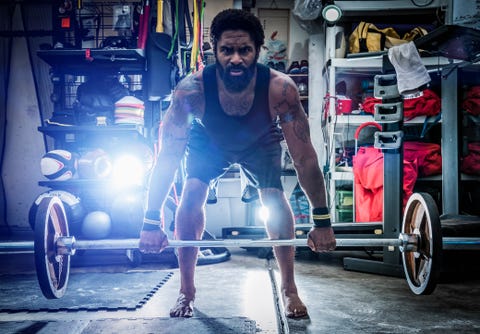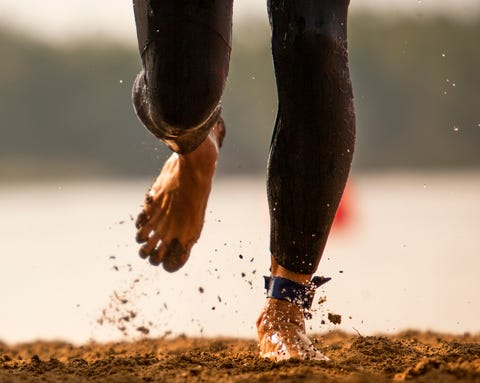How Barefoot Training Can Make You Stronger
Ditch your footwear (sometimes) to make serious gains in strength and power.
The performance footwear arena is as full of game-changing workout tech as it’s ever been, with sneakers that can make you run faster, deadlift more weight, or dominate your next WOD. But the best training footwear of all very well may be no training footwear.
That’s right: Training barefoot just might be the secret to a bigger, stronger you. And yes, it is a thing, especially in the powerlifting crowd.
Nobody will blame you for not wanting to walk around your gym in socks — or giving the guys who walk around in socks in your gym a little side-eye. Truth be told, the research on barefoot training is scant, so most of the claims on its usefulness may very well be overstated. But used it in the right situations, and it can have benefit.
The Case for Barefoot Training
Our body is a feedback loop of information. When any part of our body touches something or is even in close contact with something, it sends a signal to our brain. Our brain then sends a signal back.
That means our feet are a feedback mechanism as well, but they’re a feedback mechanism that we constantly cover in, well, footwear. Again, research is scant on how much impact bare feet can have on this feedback loop. But this feedback loop is critical to our body’s proprioception (awareness of where we are in space) and its kinesthetic awareness (ability to perform movements without thinking.
In theory, going barefoot will give our brain more feedback. That can prevent injuries.
“Proprioceptive training is an essential element of the rehabilitation process. Not only can it lead to an increase in strength and mobility, but more importantly it can drastically reduce the risk of reinjury.”, says Dr. Mohammad Rimawi, DPM, AACFAS, a Board Qualified Foot & Ankle Surgeon in NYC.

JACOBS STOCK PHOTOGRAPHYGETTY IMAGES
Barefoot training may also help build the strength in your intrinsic foot muscles, an underrated way to help injury-proof your body. Think of it like training with gloves in the gym, a practice that’s increasingly utilized less among seasoned lifters. You don’t train with gloves in the gym, in theory, so you can more aggressively grip whatever bars you’re using, and feel the varying thicknesses of those bars. That can help develop forearm and gripping muscle.
Similarly, barefoot training may help build the strength in your intrinsic foot muscles, an underrated way to help injury-proof your body. “Under the proper supervision barefoot training may lead to an increase in balance and proprioception,” says Rimawi.
The Case Against Barefoot Training
The argument you’ll often hear is that we’ve evolved to wear shoes, so why wouldn’t we wear shoes? Shoes obviously also offer valuable protection in certain training situations, providing some protection for your foot from, say, a dropped dumbbell or an accidental kick of a metal bar.

PGIAMGETTY IMAGES
Rimawi adds that barefoot training doesn’t work well if you have mechanical issues in your foot already, especially if you rush into it after years training in sneakers. “If done too quickly,” he says, “it can exaggerate conditions such as tendinitis, stress fractures, arch pain and much more.”
Translation: This isn’t something you just leap into. If you want to barefoot train, I suggest starting with only small doses of it in your workout, because it does take some time to adjust to it after years of working out in sneakers. Start by adding 5 to 10 minutes of barefoot training to your workouts, then gradually add to that amount.
Stealth Barefoot Training
Barefoot training makes more sense than you think, especially within weightlifting circles. After all, aside from the elevated heel in most weightlifting shoes, weightlifting shoes essentially work by placing your foot in a barefoot situation; they’re meant to be firm and rigid (instead of cushioned, as most sneakers are), creating a sturdy, almost wooden platform.
That allows you to increase your force production when you’re doing such lifts as deadlifts and squats, since you push through a hard surface with your heels, instead of some cushioned sole. By and large, weightlifting shoes stealthily barefoot-train your feet. So most lifts you might do in weightlifting shoes, like deadlifts and squats, can be done barefoot.
When To Barefoot Train
You can generally barefoot train your deadlifts and squats, as described above. Any movement that has you using your intrinsic foot muscles more can benefit from barefoot training (although I’m not suggesting barefoot running, something I’ll explain in another column).
The lone exception to this is plyometrics. I believe that box jumps, broad jumps, tuck jumps, and similar exercises are better trained with footwear on. These movements place stress on your foot ligaments and tendons. If your foot isn’t strong enough for these movements, cross-trainers can help absorb the shock and decrease your risk of injury.
Try these other lifts barefoot, too, and reap the benefits of this style of training.
Single-Leg Deadlift
Single-leg deadlifts are great for your legs in general; by doing this move barefoot you really train your foot muscles to grip the floor more aggressively. You also add a strong proprioceptive training component to the move. To do the single-leg deadlift, stand with dumbbells or kettlebells held at your sides. Lift your left foot an inch above the ground. Tighten your core. Keeping a tall spine, hinge at your hips and fold your torso forward until your chest is nearly parallel with the ground; try to kick your left leg back as you do this. Pause, then stand back up. That’s 1 rep; do 3 sets of 8 to 10 reps per side.
Kettlebell Swing
Doing the kettlebell swing barefoot will help you coax even more power from your swing as you plant your feet and drive into the ground harder (in much the same way we’ve discussed the deadlift and squat).
To do the kettlebell swing, stand with holding a single kettlebell with both hands, arms hanging naturally, feet a little wider than shoulder-width. Squeeze your core and glutes. Swing the kettlebell forward to create momentum, then, keeping a flat back, as if doing a plank, let the kettlebell swing back between your legs, your torso following it. Bend your knees slightly to accommodate the movement. Once it’s past your butt, explosively hinge at your hips and stand up; this will lead the kettlebell to swing forward. Squeeze your glutes as you do this. That’s 1 rep; do the move for 40 seconds on, 20 seconds off, for 4 minutes.
Staggered-Stance Overhead Press
Doing this lift barefoot will improve both the mobility of your metatarsals, the long bones in your foot that eventually lead to your toes. To do the staggered-stance overhead press, stand holding a kettlebell in your right hand at your chest. Shift your right foot backwards about a foot, so you have to stand on the balls of your right foot. Bend your left knee slightly. Squeeze your glutes and core. Now, press the kettlebell overhead, then lower it back to your shoulder. That’s 1 rep; do 3 sets of 8 to 10 reps per side.
